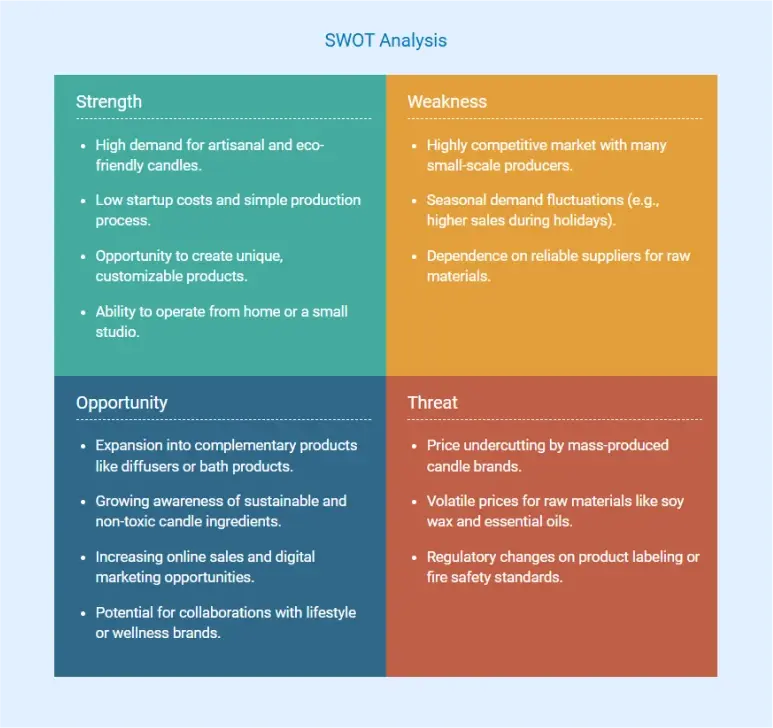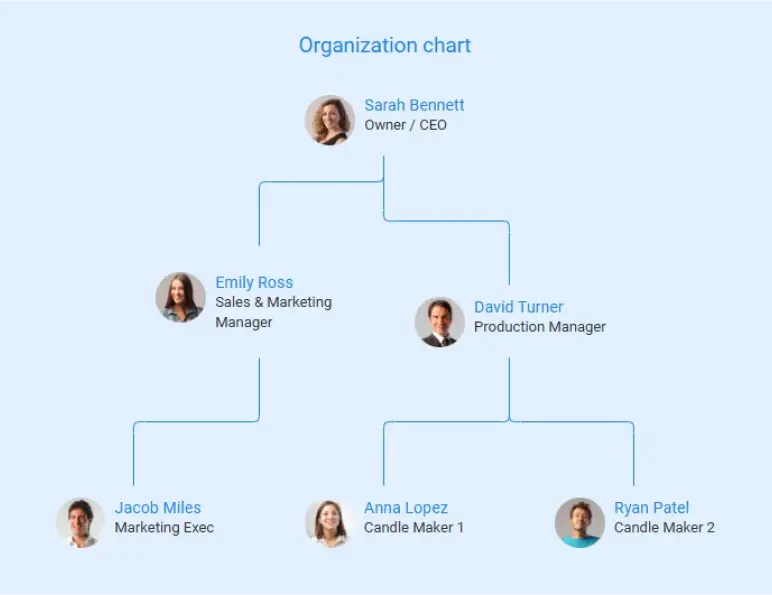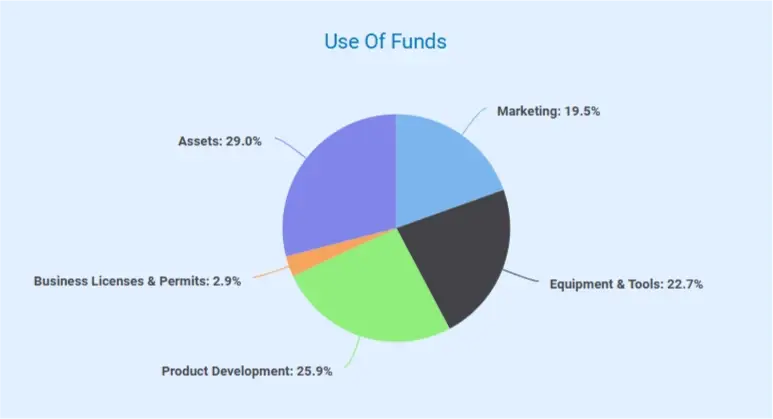Thinking about selling your own candles? You’re not alone.
With the global market on track to hit $23 billion by 2033, it turns out people really like things that smell nice and flicker.
And why not? Candle making is one of those rare businesses where low startup costs meet high profit margins and endless room to experiment (lavender-vanilla-coffee? Go for it).
But before you go all in, there’s something you’ll definitely need: a proper business plan. One that lays out your costs, pricing, and how to actually turn those cozy vibes into real sales.
Not sure where to begin?
This candle making business plan template will help you map it all out.
How to Write a Candle Making Business Plan?
Writing a candle making business plan is a crucial step toward the success of your business. Here are the key steps to consider when writing a business plan:
1. Executive Summary
An executive summary is the first section of the business plan intended to provide an overview of the whole business plan. Generally, it is written after the entire business plan is ready. Here are some components to add to your summary:
Here’s how you can approach this section:
- Start by sharing your candle business idea and what makes it special or different from others in the market.
- Briefly explain what customers need or gap your candles are solving.
- Describe who your customers are. Include basic details like age group, where they live, and what kind of lifestyle they have.
- Outline the types of candles you’ll offer (talk about the quality, pricing).
- Discuss how you will market your products and manage daily operations.
- List your team members, what they do, and any useful experience they bring to the business.
- Conclude with a clear outline of your financial objectives, detailing your initial expenses, revenue aspirations, and expansion strategies.
Ensure you keep your executive summary concise and clear, use simple language, and avoid jargon.
Say goodbye to boring templates
Build your business plan faster and easier with AI
Plans starting from $14/month

2. Business Overview
The business overview section should give readers a clear, complete picture of your candle making business and what it stands for. The essential details to include in this section are:
About the business
Provide all the basic information about your business in this section, like:
- Name of the business
- Type of candle business (homemade manufacturer, factory-produced, organic)
- Company structure (sole proprietorship, partnership firm, or something else)
- Location of your business (reason for location selection)
Ownership
Explain who started or owns the candle business and what their role looks like in everyday work. If there are multiple owners, mention how ownership is divided and what each person brings to the table.
Mission & vision statement
Write a short mission that captures what your candle business is really about, why it exists, and who it serves. Follow that with a vision that shares what you hope to build over time. Keep both statements simple, clear, and true to your brand’s personality.
Business history
Share a brief history of how your candle business started and evolved over time. Include key milestones, challenges you’ve overcome, and any notable achievements. This helps readers understand your journey and credibility.
Future goals
Share what you see ahead for your candle business. Maybe you’re thinking of opening another store, starting an online shop, or reaching more customers in new cities. Be real about your goals; it helps people understand that you’re thinking ahead and working toward something bigger.
Basically, after reading this section, one should get an in-depth understanding of your candle making business.
3. Market Analysis
Doing market analysis provides a clear understanding of the environment in which your candle making business will operate. It outlines your target market, competitors, industry trends, regulatory factors, and growth opportunities.
Your market analysis should include the following essential components:
| Component | What to Include |
|---|---|
| Target Market | Define your ideal customer and their preferences (e.g., scented, beeswax, tealights, decorative candles). |
| Market Size & Growth | Overview of the candle industry, including size, trends, growth potential, and any regulatory considerations. Highlight how your business stands out. |
| Competitive Analysis | Identify local competitors (direct and indirect), analyze their strengths/weaknesses, and explain your competitive advantage. |
| Market Trends | Explain current and emerging trends in candle making and how your business will adapt (e.g., seasonal demand, eco-friendly products, gift packaging). |
| Regulatory Environment | List applicable regulations or licenses (e.g., safety standards, labeling laws, business registration, tax compliance). |
Also, try to include a structured SWOT analysis to show you understand your business environment. Here’s an example:

Additional tips for writing the market analysis section of your business plan:
- Use industry reports, market research, and surveys for reliable data.
- Be specific and provide detailed, clear information.
- Include charts and graphs to illustrate key points.
And always remember, while drafting this section, keep your target audience in mind.
4. Products And Services
The product and services section of a candle manufacturing business plan should describe the specific products that will be offered to customers. To write this section should include the following:
- Product range: List the types of candles you’ll offer, such as scented, decorative, taper, pillar, or soy varieties.
- Shipping and delivery: Describe how you’ll manage shipping logistics and outline any additional fees or delivery options for customers.
- Focus on quality: Highlight your commitment to product quality and explain the steps your business will take to maintain high standards.
Including your products with clear, upfront pricing immediately gives readers a solid understanding of what you offer and how you’re positioned in the market.
For example:
| Product Name | Type | Description | Price Range (USD) |
|---|---|---|---|
| Classic Jar Candles | Scented/Jar | Soy wax candles in reusable glass jars with various fragrances | $10–$18 |
| Rustic Pillar Candles | Pillar | Decorative, unscented, or mildly scented pillar candles | $10–$18 |
| Elegant Taper Candles (Set) | Taper | Long, slender candles for decorative and dining settings | $12–$20 (per set) |
| Botanical Wax Melts | Wax Melts | Wax cubes infused with natural elements like dried flowers | $6–$10 |
| Travel Tin Candles | Portable/Tin | Compact candles in tins are ideal for travel or small gifts | $6–$12 |
| Holiday-Themed Candles | Seasonal/Decor | Limited edition candles with seasonal scents and festive designs | $12–$20 |
| Eco Soy Votive Candles | Votive/Soy | Small soy wax candles are ideal for ambient lighting | $4–$7 (each) |
| Custom Label Candles | Personalized | Candles with customized labels for weddings or corporate events | $15–$25 |
The products and services section should be clear, detailed, and customer-focused, helping investors and readers quickly understand the value your business brings.
5. Sales And Marketing Strategies
To grow your candle business, you need a solid sales and marketing strategy that attracts customers, builds your brand, and keeps buyers coming back.
Here’s how you can approach it:
- Emphasize the unique qualities that set your candle business apart and make it a preferred choice.
- Set prices for your products that are equitable, competitive, and still allow you to make profits.
- Market your brand through a combination of digital and traditional strategies.
- Create a tidy, user-friendly website that showcases your products.
- Remain engaged on platforms such as Instagram or Pinterest, where your audience explores.
- Utilize content, emails, and periodic promotions to remain present in customers’ minds.
- Attend local markets, pop-up events, or seasonal fairs to connect with buyers in person.
- Provide options such as bundles, personalized fragrances, or exclusive collections to boost sales.
- Encourage repeat visits through loyalty rewards, little gifts, or excellent service.
Your sales and marketing strategy should be clear, realistic, and personalized to your audience, while staying flexible enough to evolve with trends and feedback.
6. Operations Plan
Your operations plan is all about showing how you’ll keep your candle making business running smoothly day to day. It covers how you’ll build your team, manage production, and ensure you have everything you need to get the job done.
Here are 3 important components for your operational plan:
Hiring Plan
Discuss the people required to assist in managing operations. What is the number of employees you intend to recruit? What activities will they engage in, such as candle making, order packing, managing shipping, or conducting quality checks?
Additionally, specify the type of experience or abilities you expect from them, and mention any advantages or benefits you will provide to maintain employee satisfaction
Operational Process
Explain how you’ll actually make and sell your candles. Walk through the main steps: melting and pouring wax, adding scents, curing, labeling, and packing.
Don’t forget how you’ll keep track of inventory, handle orders, and ensure everything meets your quality standards. This helps show you’ve thought through how it will all work in practice.
Equipment and Raw Materials
List the main tools and supplies you’ll need. Like:
- Pouring pots
- Molds & scales
- Wick holders
- Stirring sticks
- Wax
- Fragrances or essential oils
- Labels
- Packaging materials
Talk a bit about how you’ll get these supplies and ensure you always have enough on hand so production doesn’t get held up.
By stating these details clearly, anyone reading your plan will see exactly how you’re going to keep your candle making business running smoothly.
7. Management Team
The management team section gives an overview of the people responsible for running your candle making business. Utilize this section to showcase the experience and qualifications of each team member, while clearly outlining their respective roles.
Mention the key people on your team, such as:
- Managers: Owners and senior managers who are responsible for strategic decisions
- Staff: Sales, marketing, packaging, shipping, quality control, and operations team members
Outline your organizational structure by explaining reporting lines and how decisions will be made. Clarify who leads which area and how different departments will work together to ensure smooth daily operations. For example:

If you have a board of advisors, mention them here along with their roles and experience to show the expertise guiding your business.
Overall, use this section to showcase your company’s key personnel and make it clear why your candle making business has the right team in place to succeed.
8. Financial Plan
Your financial plan is a key part of your candle making business plan. It shows that you understand your costs, pricing, and how your business will make a profit.
When creating this section, aim for clear, realistic projections that cover your first three to five years in business. Here’s what to include:
1. Profit & Loss Statement
Outline projected revenue, cost of goods sold (wax, wicks, scents, packaging), operating expenses (rent, utilities, marketing), and expected net profit or loss.
2. Cash Flow Statement
Estimate monthly cash inflows (sales receipts) and outflows (supplier payments, rent, salaries, loan payments). This helps ensure you have enough cash on hand during slower months.
Below is a sample table to help you understand how to organize these details clearly:
| Category | Year 1 (USD) | Year 2 (USD) | Year 3 (USD) |
|---|---|---|---|
| Cash Inflows | |||
| Sales Revenue | 75,000 | 110,000 | 145,000 |
| Other Income (e.g., Workshops) | 2,000 | 3,500 | 5,000 |
| Total Inflows | 77,000 | 113,500 | 150,000 |
| Cash Outflows | |||
| Raw Materials & Supplies | 15,000 | 22,000 | 28,000 |
| Salaries & Wages | 18,000 | 24,000 | 30,000 |
| Rent & Utilities | 6,000 | 7,200 | 8,000 |
| Marketing & Advertising | 8,000 | 10,000 | 12,000 |
| Packaging & Shipping | 4,000 | 6,000 | 7,000 |
| Equipment Maintenance/Upgrade | 2,000 | 3,000 | 3,500 |
| Professional Services | 1,200 | 1,500 | 1,800 |
| Miscellaneous Expenses | 1,500 | 2,000 | 2,200 |
| Total Outflows | 55,700 | 75,700 | 92,500 |
| Net Cash Flow | 21,300 | 37,800 | 57,500 |
| Beginning Cash Balance | 0 | 21,300 | 59,100 |
| Ending Cash Balance | 21,300 | 59,100 | 116,600 |
3. Balance Sheet
List expected assets (equipment, inventory, cash reserves) and liabilities (loans, payables). Show projected owner’s equity.
4. Break-Even Analysis
Calculate the sales volume needed to cover all costs. Knowing your break-even point helps you set realistic sales goals and pricing.
5. Financing Needs
Detail how much money you’ll need to launch and run the business. Include equipment, supplies, initial inventory, marketing costs, and working capital. Specify whether you’re seeking loans, investor capital, or personal funding.
6. Cost Assumptions
List your expected unit costs for materials, packaging, and shipping. Show your markup and expected gross margin.
Also, if you’re planning to secure funding, be sure to clearly state how much you need and how the money will be used. Break down the costs in detail so potential lenders or investors can see exactly where their money is going.
For example, you might show $25000 fund usage like:
| Category | Description | Estimated Cost (USD) |
|---|---|---|
| Equipment & Tools | Candle molds, wax melter, thermometer, pouring pots | $3,000 |
| Raw Materials | Wax, wicks, fragrance oils, dyes, jars, packaging | $5,000 |
| Branding & Packaging | Label design, logo, custom packaging | $2,000 |
| Website & E-commerce Setup | Domain, hosting, web design, payment gateway setup | $2,500 |
| Marketing & Advertising | Social media ads, influencer collaborations, SEO | $4,000 |
| Business Licenses & Permits | Legal paperwork, registration, local permits | $500 |
| Initial Staff Wages | Hiring support staff for production & fulfillment | $3,000 |
| Workspace Rental | Rent for small workshop/studio space | $3,500 |
| Contingency Fund | Emergency or unexpected expenses | $1,500 |
| Total | $25,000 |
Using visuals like tables or pie charts explains clearly how funds will be used. And, it makes it easier for the lender or investor to understand it at a glance.
Look at the fund’s usage chart:

9. Appendix
The appendix is where you add any extra details that support the main content without cluttering the main sections. It helps investors or readers find all the relevant documents, data, and materials in one organized place.
You can include:
- A table of contents for the appendix itself
- Market research and industry data (like the size of the candle making industry, trends, and consumer demographics)
- Financial statements (income statements, balance sheets, cash flow projections for at least three years)
- Legal documents (permits, licenses, contracts)
- Supporting materials (marketing brochures, product photos, operational procedures)
Use clear headings and labels so readers can easily find what they need, and remember to include only essential information that truly supports your plan.
Download a free candle making business plan template
Ready to start your own candle making business? But need a little help putting your plan together? Don’t worry, we’ve got you covered! Download our free candle making business plan template PDF to give yourself a head start.
This template offers a ready-made format with helpful prompts so you won’t miss any essential details. It guides you through all the important sections, from the executive summary to detailed financial projections.
The Quickest Way to turn a Business Idea into a Business Plan
Fill-in-the-blanks and automatic financials make it easy.
Summary
Now that you’ve explored this helpful guide, drafting your own candle making business plan should feel a lot simpler.
But if you’re still not sure about certain sections or want an even easier way to create a plan, Upmetrics can help. It’s modern business planning software designed to make the whole process stress-free with the power of AI.
With features like accurate financial forecasting, market analysis, and professional templates, you can craft a professional, investor-ready plan without any stress.
So, why wait? Start planning your candle business today!



